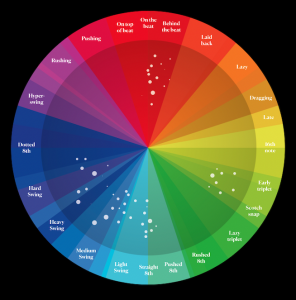
All the items in this portfolio are driven by a common motivation: The desire to identify, develop and deploy the expressive rhythmic mechanisms which ‘fall between the cracks’ of standard notation and terminology, here termed simply time-feel. Even in jazz, the genre perhaps most associated with such sub-notational rhythmic nuance, there is an incongruity between the expressive and stylistic importance of “this most basic fundamental element” (Crook 1991, p.10) claimed by practitioners, and the clarity, extent of, and even willingness for its illumination. On the rare occasions when jazz educators and practitioners mention such elements, they tend to do so fleetingly, inconsistently and with little attempt at objectivity, particularly in comparison to pitch, scale and harmonic structures (Mermikides 2020). In the academic field however, significant research has been undertaken, particularly in the last 30 years when digital technologies allowed the “uber-virtuosity” (Danielsen 2010) of objective audio analysis and reproduction, at and beyond the limits of human perception (see for example, Dittmar et al 2017).
The peer-reviewed academic papers in leading journals (Routledge, Soundboard Scholar), and international keynotes and presentations in this portfolio contribute to this field, with an original time-feel model which distinguishes and resynthesizes the elements of subdivision (a)symmetry (‘swing’), displacement against a negotiated time-line (‘latency’) and dynamic, timbral and note-length considerations (‘weighting’) [SMT]. This has illuminated expressive mechanisms in the playing of John Coltrane (Straight and Late), Django Reinhardt, Roland Dyens (link Monitored Freedom) and a diverse range of artists and genres (All the Feels), as well as informed pedagogical practice and materials.

Such output has been published as the Art of Timing cover feature in Guitar Techniques Magazine (Issue 275) – the first known significant engagement with time-feel in a guitar music instruction publication – which one reader called “a brilliant article […] tantamount to being an encyclopaedia on timing, feel and groove, and something perhaps we should all keep by for reference”.
This research was also presented as a cover feature of Soundboard Scholar (which includes alongside analysis, detailed guides for the execution of jazz time-feel), an international touring workshop Breaking 44 for electronic musicians, an hour-long interview dedicated to the subject on the Guitar Hour Podcast, and the publication of Kronókosmos – a collection of expressive rhythmic etudes for the development of time-feel for all instruments and genres. This is presented in both standard and intuitive graphic notation, and integrates with the Mingus software, in order to diversify its users and modes of engagement.
Crook, H. (1991) How To Improvise. Rottenburg: Advance Music.
Danielsen, A. (ed.) Musical Rhythm in the Age of Digital Reproduction. Farnham: Ashgate.
Dittmar, C. et al (2017) “A Swingogram Representation for Tracking Micro-Rhythmic Variation in Jazz Performances,” Journal of New Music Research 47, no. 2: 97–113
Mermikides, M. (2020) “‘Straight and Late’: Analytical Perspectives on Coltrane’s Time-Feel,” Jazz Perspectives 12, no. 1: 147–66.
